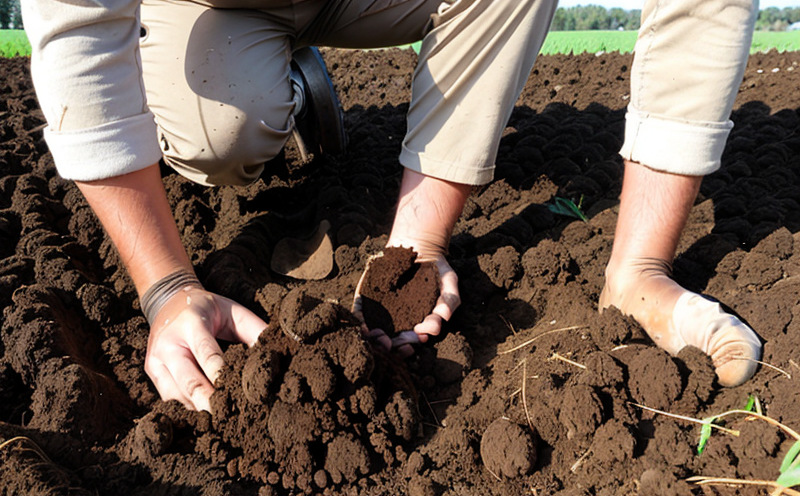Soil Copper Content Testing
The testing of soil copper content is crucial in agricultural and forestry sectors as it directly impacts crop yields, plant health, and overall sustainability. Copper plays a vital role in the growth and development of plants; however, its presence beyond safe levels can lead to toxicity issues, affecting both the environment and human health.
Copper is often found naturally in soil but can also be introduced through fertilizers or other agricultural inputs. Excess copper accumulation can cause damage to plant roots, reduce nutrient uptake, and even kill plants if not managed properly. Soil testing helps farmers understand the current levels of copper present in their land, ensuring they do not exceed safe thresholds.
The process involves collecting soil samples from various locations within a field or forested area. Samples are then prepared according to specific protocols before undergoing analysis using advanced analytical techniques such as atomic absorption spectroscopy (AAS) or Inductively Coupled Plasma Mass Spectrometry (ICP-MS). These methods provide precise measurements of copper concentrations, allowing for accurate interpretation and management.
Understanding the copper content in soil is essential for developing effective remediation strategies when contamination occurs. For instance, if too much copper has accumulated due to improper application practices or leaching from nearby industrial sites, corrective actions might include adjusting fertilizer types or applying amendments like chelating agents which help bind excess metals.
Regulatory bodies like the ISO, American Society for Testing and Materials (ASTM), European Committee for Standardization (CEN) provide guidelines on how to conduct these tests reliably. Compliance with such standards ensures consistent results across different laboratories, which is critical when comparing data between regions or over time.
In summary, soil copper content testing offers valuable insights into the health of agricultural and forested lands by providing quantitative information about metal concentrations. This knowledge enables informed decision-making regarding management practices aimed at maintaining optimal conditions for plant growth while minimizing risks associated with excessive copper levels.
Why It Matters
The importance of soil copper content testing cannot be overstated, especially within the agricultural and forestry sectors where soil health is paramount. By monitoring copper levels, farmers can ensure that their crops receive adequate amounts necessary for healthy development without risking overexposure.
- Enhanced Crop Yield: Optimal copper levels support robust root systems and improved nutrient absorption capabilities in plants, ultimately leading to higher yields.
- Improved Plant Health: Proper management of soil copper prevents deficiencies that could stunt growth or cause stunted development.
- Sustainable Practices: Understanding copper content allows for sustainable farming methods by avoiding unnecessary applications of copper-containing fertilizers.
In addition to these benefits, accurate testing also supports compliance with environmental regulations aimed at protecting natural ecosystems from harmful pollutants. Properly conducted tests contribute towards maintaining biodiversity and preserving long-term ecological balance.
Applied Standards
The International Organization for Standardization (ISO) has established several relevant standards that guide soil testing procedures, including ISO 17025:2017 which sets requirements for the competence of testing and calibration laboratories. Another key standard is ISO 6384-1:2016 dealing with the determination of copper in soils by flame atomic absorption spectrometry.
The American Society for Testing and Materials (ASTM) provides additional guidance through its E59 standard, which covers methods of sampling and testing soil and rock. Similarly, European standards like EN 14872:2016 offer harmonized approaches to measuring copper concentrations in agricultural soils using various analytical techniques.
These international standards ensure consistency and accuracy in soil copper content testing across different countries and laboratories. Adherence to these guidelines helps maintain reliability in reported results, facilitating effective communication between stakeholders involved in agricultural production and environmental protection initiatives.
Use Cases and Application Examples
- Farm Field Assessments: Soil copper content testing is commonly used during initial site evaluations to determine baseline values before implementing new cultivation practices or expanding operations into previously unused areas.
- Agronomic Research: Researchers studying the effects of different fertilizers on plant performance may measure soil copper levels pre- and post-treatment to assess any changes resulting from varying input types.
- Environmental Monitoring: After industrial activities cease, land reclamation projects often involve extensive soil testing to identify residual pollutants like copper before initiating restoration efforts.
By understanding the specific needs of each use case, laboratories specializing in soil analysis can tailor their services accordingly, ensuring accurate and reliable results that meet client expectations and regulatory requirements.





